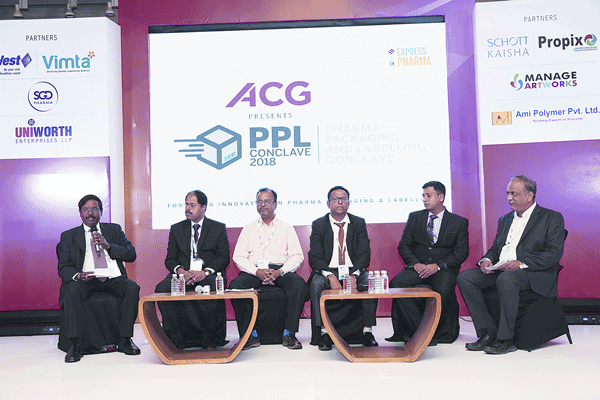The PPL Conclave’s final panel discussion was on, ‘Packaging in Parenterals: Challenges and Opportunities’.
The panelists were Prof MS Sarveswara Rao, Strategic Advisor, GreatFour Systems & Adjunct Faculty, SVCP (Moderator); Soumyanath Mishra, Head & DGM, Packaging Development-F&D, Mankind Research Centre; Munindra Roy, Head – Packaging Development, Gland Pharma; Santanu Shome, GM – Procurement Direct Materials, Hospira Healthcare India (A Pfizer Company); Prasad Satam, Head- Packaging Development, Aurobindo Pharma and Ajay Bapat, Head Packaging, Emcure.
Rao, the moderator for this session, gave an overview on parenterals as a dosage form and elaborated on its unique features and benefit. He also highlghted the huge growth potential in this segment, especially for India. He explained that in case of parenterals, the packaging is often also the drug delivery system and hence the challenges are also manifold. Giving a rundown on the packaging challenges in parenterals, he emphasised on inter-departmental collaboration as a measure to tackle them effectively.
Roy, at the behest of the moderator, expounded on the differences between parenterals and other dosage forms and spoke on primary packaging challenges in this segment. He pointed out that product-package compatibility, transportation, regulatory compliance etc. are some of the factors that need to be taken into consideration while implementing packaging solutions for this segment. He recommended packaging professionals to consider these factors in the design stage itself to avoid hassles in the long run and prevent product recalls, a major problem for the pharma industry in the recent times.
Bapat expounded on secondary and tertiary packaging challenges and his emphasis was on child-resistant and elderly-friendly packaging. He said that in times of self-medication, packaging has to do its best to enable safety, ensure quality and provide convenience to the users. He also spoke on developing parenterals for oncology and how packaging needs to be designed with utmost care for complex therapeutic areas.
Key takeaways
- Packaging comes with its unique set of opportunities and challenges. Increase R&D in this segment to come up with apt solutions.
- Adopting QbD is one of the most effective ways to mitigate risks through packaging
- Partnerships can be pivotal in developing innovative and out-of-the-box solutions for parenteral packaging.
Satam was quizzed by the moderator on the design aspects of packaging solutions for parenterals. He spoke on risk mitigation through quality by design (QbD) in packaging. He further informed about the importance of choosing the vials, stoppers, tubes etc. for parenterals to strike the right balance between cost, quality and efficacy of the product. He advised his peers and colleagues to pay attention to even the smallest detail when it comes to parenteral packaging.
Mishra drew parallels between different packaging materials for parenteral packaging and examined their pros and cons. He compared glass and plastic containers and explored the advantages and disadvantages of each material when it comes to packaging of products with complex molecules.
Shome explained about concepts such as zero-defect supplies and quality control through such methods. He also elaborated on the role of good partnerships in fostering a culture of innovation in pharma companies. He presented the examples of his company’s various partnerships to come up with both, pertinent and out-of-the-box solutions. He recommended increasing research in packaging to come up with apt solutions.
The panel also reiterated that parenterals as a segment is poised to grow in future.
- Advertisement -



Comments are closed.